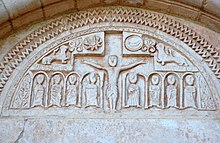Sun and moon (iconography)


The combination of sun and moon , known as personifications since ancient times, became an iconographic attribute of the crucifixion of Christ in Western Christian art .
History and use
Antiquity
In ancient times, the sun and moon were symbols of rule and also appeared personified in mythology as Sol and Luna (Greek: Helios and Selene ).
Christianity
In early Christian art, the stars served to glorify Christ . In the early Christian representations, the heavenly bodies first appear as astronomical structures in the context of the crucifixion death; in the 9th and 10th centuries, at the time of the Carolingians and Ottonians , the ancient tradition of personification prevailed.
The sun and moon are also seen as symbols for spiritual and worldly power , as in the case of the old tower coronation of the Stephansturm in Vienna.
As allegorical figures, the sun and moon were often depicted as half-length portraits on a clipeus , the sun with a halo around its head and the moon with a sickle in its hair. In the context of the crucifixion death, these figures often appeared weeping and hid their faces behind a dress or a cloth, for example in Codex Egberti from the 10th century. Not infrequently in this context, in addition to the sun and moon, earth and sea were also portrayed personified in order to express the all-encompassing meaning of the crucifixion death.
Alchemy
The allegorical figures sun and moon also found their way into alchemical literature (such as De Alchemia ).
literature
- Lexicon of Christian Iconography . Freiburg 1994/2004; Fourth volume, col. 178-180
- Christian Rietschel : Symbols of Faith . Berlin 1965
Web links
Individual evidence
- ^ Ferdinand Opll: The siege of the Turks in Vienna and the collective memory of the city. In: Karl Fischer (Ed.): Studies on Viennese history. Yearbook of the Association for the History of the City of Vienna JbVGStW, Volume 64/66 (2008/2009). Association for the History of the City of Vienna. Vienna 2013. ISSN 1027-8788 ZDB -ID 1160253-3 . P. 177 with reference to: Birgit and Thomas Ertl: Sun and Moon: The crowning of the tower on St. Stephen's Cathedral between the two Turkish sieges. In: Wiener Geschichtsblätter Volume 52, year 1997. ISSN 0043-5317 ZDB -ID 2245-7 p. 65.
- ↑ Lexicon of Christian Iconography, 4 (1994/2004), Sp. 178–180
- ↑ See for example Joachim Telle : Sol und Luna. Literary and alchemical history studies on an old German pictorial poem. (= Writings on the history of science. Volume 2). Pressler, Hürtgenwald 1980, ISBN 3-87646-046-8 .
